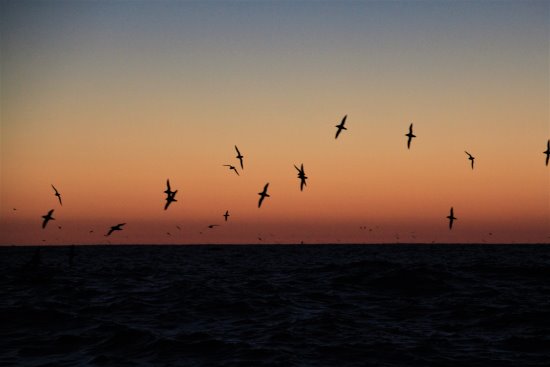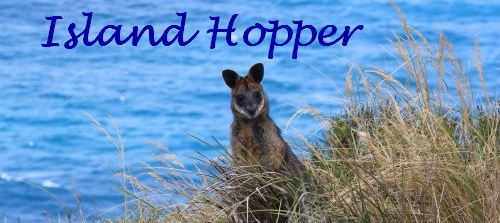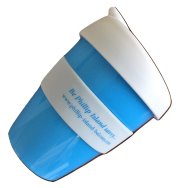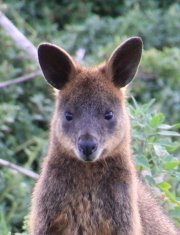Shearwater Cruise
A way
to get to know the short-tailed shearwater is by taking a shearwater cruise with
Wildlife Coast Cruises.
These cruises take place from November to February.
A walk around Cape Woolamai on Phillip Island takes visitors past the shearwater rookery which is home to 1 million birds, the second largest rookery in Australia.
The shearwaters leave Phillip Island in mid-April, returning in September – undertaking a round trip of 15,000 kilometres.
If not on their annual migration, during the day they are out at sea fishing, returning to their burrows at sunset.
Our 8.00pm shearwater cruise in January leaves a little early as all passengers have arrived early – maybe they are all as keen as we are to see the sight of the shearwaters returning to their burrows on Cape Woolamai.
The cruise on the Kasey Lee begins with a pass under the Philip Island Bridge – another way to view this important and impressive structure.
Our skipper keeps up a flowing commentary. We learn about the first island inhabitants, the Bunurong people, and he points out places of interest as we pass.

Cormorants Roost on Cape Woolamai, Phillip Island
There is a lot to interest passengers, from bird life to the old granite quarry to the rugged coast of the Cape with its caves and rocky cliffs.
All the while the friendly staff serve hot and cold nibbles as the sun slowly fades towards the horizon.
One fascinating aspect of the cruise is the source of the colour of the beautiful turquoise water around Cape Woolamai. The Cape is comprised of pink granite and the granitic sand on the seabed reflects the sunlight in the shallow water.
This can be seen more clearly on a helicopter flight over Phillip Island.

The Sun Drops Below the Horizon at Cape Woolamai
As the Kasey Lee approaches the point of Cape Woolamai the sun is setting, and is a beautiful sight as it hovers between the granite rocks and the horizon.
We then head out to sea, searching the skies for the first shearwaters to appear. The shearwaters mass out to sea, coming ashore only when the sun has set. This is to avoid predators - we pass a wedge-tailed eagle nest on the way out.
A few shearwaters appear, and then more and more can be seen sweeping over the sea, silhouetted against the peach-coloured sky – a stunning sight.
The skipper stops the engines of the Kasey Lee and we watch in the silence. The interesting thing being that the shearwaters don’t make any sound – no calls or cries. This changes when they are in the rookery! I assume they don’t want to alert predators to their presence as they gather out at sea.

Massing Shearwaters Seen From the Shearwater Cruise at Sunset Off Cape Woolamai
As the sun drops below the horizon, more and more birds appear. In January there are tens of thousands of birds, an impressive sight. But in November they number in the hundreds of thousands.
As the Kasey Lee heads back to the jetty we can see the extent of the rookery by the shearwaters flying above the cape, returning to their burrows.
With the light gone for photographs, the shearwater cruise ends with passengers relaxing with a glass of wine and agreeing that we have seen something very special.
Return to Top
Return to Flights and Cruises
Return to Home Page
Keep in touch - sign up for my free newsletter!

About Me Contact Me Site Map Privacy Policy
Copyright 2011-2025 phillip-island-balcony.com
All Rights Reserved


New! Comments
Have your say about what you just read! Leave me a comment in the box below.